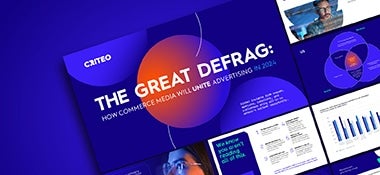Consumer attitudes are forcing brand marketers to change tactics and focus on enhanced personalisation
London, UK, 30th July 2015. Criteo (Nasdaq:CRTO), the performance marketing technology company, today released findings of a nation-wide survey investigating consumers attitudes and behaviours towards advertising, browsing and shopping online. The research found that more than a third of British consumers are frustrated by the overwhelming amount of ads online. Many recall seeing only one ad a day and admit to having a knee-jerk reaction to brand advertising – and it’s not always positive. As online advertising reaches saturation point and consumers’ attention span continues to wane, personalisation techniques have never been more important for brands to break through the noise.
Independent research conducted by Censuswide and commissioned by Criteo analysed responses from 2,200 UK adults over the age of 16 on their attitudes and behaviours towards online advertising. The importance of personalisation, repetition and colour emerged as the most common elements that convert consumers from browser to buyer.
Consumers lead with emotion
According to the findings, only four in 10 UK respondents between the ages of 16-45 confirmed they instantly feel ‘positive’ when they see an online advert. When it comes to gender, men are more likely to feel ‘extremely negative’ almost instantly, compared to less than 10 percent of women and a quarter only need to see an ad once to actively start disliking a brand. Whether it’s ad for a company they recognise or not, consumers make snap judgements and know instantly if they love or hate that brand.
“The immediate reaction consumers have to brands is forcing marketers to revaluate how they appeal to their target audience. Age, gender and demographic, coupled with advances in technology, have formed the basics of targeted advertising, but with the industry hitting saturation point, brands need to start adopting neuroscience and personalisation techniques to appeal to the individual’s subconscious and emotional triggers,” said Jon Buss, Managing Director, Northern Europe, Criteo.
Colour drives sales
Nearly a quarter of UK adults said red makes them notice an online advertisement most. It’s the colour more commonly used by brands to promote sales or offers and continues to be effective as nearly half of respondents are drawn to ads about flash sales. However, there is a clear gender split: women (22 percent) are more attracted to colour-rich advertisements compared to men (15 percent), with purple creating the greatest divide.
“Colour is a powerful tool for persuasion. Red, for example, is the only colour that universally ignites an emotional and physiological response in people. It’s arousing, increases the heart rate, and in western culture is typically interpreted as a sign of good value,” said Nathalie Nahai, web psychologist.
Repetition resonates
While consumers are frustrated by the sheer number of online ads, a third of Brits (33%) said on average they need to see an advert up to five times before they start to feel positive about that company. That said, young people are quicker to like a brand than older generations. One in 10 16-24 year olds only need to see an advert once to feel positive while a third of over 45’s take on average 2-5 times before an ad resonates positively.
Repetition coupled with personalisation is key to driving ad response rates. A third of respondents who recalled seeing an ad carried on to do more research on the product/service or visited the website or app. More than any other age group, nearly a quarter of 25-34 year olds have made a purchase straight from an ad and would do it again. While 16-24 year olds feel ads are more relevant to them than one year ago.
“Subconsciously, we tend to rely on what’s immediately in our mind to drive our decision making. ‘Availability bias’, as it’s known, is a mental shortcut that relies on immediate examples that arise in a person’s mind when evaluating a specific topic or decision. Tapping into that bias through emotionally arousing content, repetition and personalisation are vital for effective targeted advertising, but as consumers become more sophisticated about online tracking, brands need ensure they are handling their advertising with integrity and transparency,” Nahai continued.
“With 40 percent of ecommerce transactions now involving more than one device, the customer path to purchase is more complex than ever before. Brand marketers are under an increasing amount of pressure to know their consumers inside and out. While advances in technology and data analytics have breathed new life into targeted advertising, understanding how the brain works and applying neuroscience techniques to modern methods like personalisation will create a deeper understanding of a brands consumers, and ensure ads are delivered in a way that resonates with consumers” concluded Buss.
Contact:
Sarah-Anne Bray
sa.bray@criteo.com








